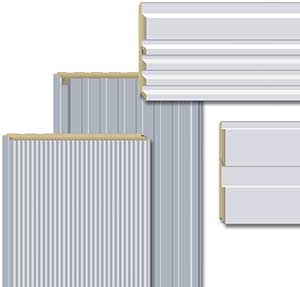Thermal and Moisture Control in Exterior Metal Walls
Vapor-Permeable Air and Water Barrier
In Cold Climates
Applied over the sheathing is a vapor-permeable air and water
barrier or retarder, usually made of woven manufactured product.
As a moisture retarder, it allows vapors to penetrate the
interior stud space cavity to pass through into the outer
drainage cavity. At the same time, it acts as a barrier to
both air and liquid water coming from the outside. Hence,
it must be fastened properly to withstand the imposed air
or water that it may be subjected to but also provide continuity
to maintain its integrity and effectiveness. Critical to good
performance, all joints must be properly taped and secured
with particular attention to detail at the window and door
heads, sills, and jambs.
Drainage Cavity
The outer material is often referred to as a rainscreen, particularly
if it is a metal material that is not intended to be airtight
and is primarily intended to be the weathering surface that
screens the rest of the wall system from rain and other elements.
It may be attached in various ways that penetrate through
the air and water barrier and gypsum sheathing into the studs.
The space created between the rainscreen and the barrier-covered
sheathing is called the drainage cavity. It must have enough
space for moisture to properly drain out and still accomplish
air pressure equalization, which is important in windy conditions.
The drainage cavity is sometimes divided into compartments
that help maintain pressure equalization.
5. Rainscreens
The term rainscreens refers to the outer material in a wall system, usually when it is made out of metal cladding. There are several different metal cladding types:
Single Skin or Roll-Formed units.
This common type of metal cladding has very desirable design
characteristics. These materials provide variations in texture
from light striations to bold ribs, which can provide light
or bold textures. They can also be installed to run horizontally
or vertically.
Foam Insulated units.
Metal cladding may also be an insulated composite (Figure
10) . Design characteristics of this metal cladding type include
high-performance pressure equalized joinery, and the ability
of the units to be curved to various radii. They also can
be installed in horizontal or vertical applications, using
both wide horizontal reveals and wide vertical reveals recessed
to the same plane as a standard detail. They integrate easily
with glass curtainwall and windows.
|
Thin Composite Metal Units
Thin metal composite walls consist of two layers of metal,
with a composite core that is either formed or fabricated
into a panel system. Some joinery systems have geometry that
is a pressure-equalized rainscreen. These composite walls
are created for superior flatness, wide modules, and grid
look. Design characteristics include crisp sight lines, smooth
curves, and a high-tech grid look.
Plate Systems
Plate systems are available in many types of designs. They
generally are used on medium or high-rise construction.










